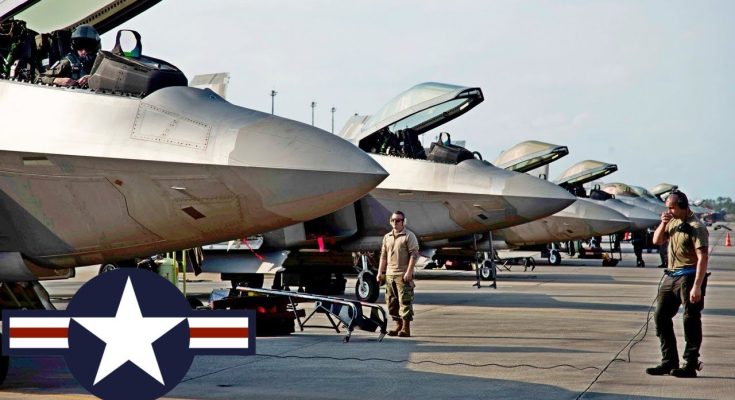U.S. Air Force: F-22 and F-15 Fighter Jets During Large-Scale Military Exercises in Florida
The U.S. Air Force (USAF) regularly conducts large-scale military exercises to ensure the readiness of its forces and to maintain a strategic edge over potential adversaries. One of the most significant exercises featuring advanced fighter aircraft is held annually in Florida, where the F-22 Raptor and F-15 Eagle fighter jets play central roles in enhancing the operational capabilities of the U.S. Air Force and its allies. These exercises, which simulate real-world combat scenarios, test the combat effectiveness, coordination, and agility of the forces involved.
The Role of the F-22 Raptor
The F-22 Raptor is a fifth-generation, stealthy, air dominance fighter jet designed for both air-to-air and air-to-ground combat. It is renowned for its unmatched stealth capabilities, advanced avionics, and superior maneuverability. The F-22 combines advanced radar-evading technology with cutting-edge sensors, which allow it to detect and engage enemy aircraft at extended ranges, all while remaining undetected by adversaries. This makes the F-22 a vital asset for the U.S. Air Force in ensuring air superiority in any conflict.
In large-scale military exercises, the F-22 often takes on the role of air superiority fighter, tasked with securing dominance in the skies. Its stealthy nature allows it to infiltrate enemy defenses undetected, while its agility and advanced radar systems enable it to engage enemy aircraft with extreme precision. The F-22 is also equipped with sensor fusion technology, integrating data from various sources to provide the pilot with a comprehensive picture of the battlefield. This allows the aircraft to perform complex operations, such as simultaneous air-to-air and air-to-ground strikes, while maintaining dominance over enemy forces.
The Role of the F-15 Eagle
The F-15 Eagle is a time-tested fighter that has been a cornerstone of the U.S. Air Force since the 1970s. Known for its speed, firepower, and agility, the F-15 is a dedicated air superiority fighter that excels in long-range engagements and dogfights. With its proven combat record, the F-15 is still a vital part of the Air Force’s fleet, frequently participating in exercises designed to enhance both air-to-air and air-to-ground capabilities.
During military exercises in Florida, the F-15 plays a complementary role to the F-22. While the F-22 leads the charge in air superiority missions, the F-15 can be tasked with supporting air-to-ground operations or participating in multi-role combat missions. In these exercises, F-15 pilots work in tandem with F-22 pilots, allowing both aircraft to demonstrate their complementary strengths. The F-15’s large payload capacity and ability to carry a variety of munitions, including precision-guided bombs and missiles, make it an indispensable asset for strike missions during these large-scale exercises.
Large-Scale Military Exercises in Florida
Florida provides an ideal environment for conducting large-scale military exercises. The state’s extensive airspace and varied terrain offer a dynamic training ground for the Air Force to test tactics, techniques, and procedures (TTPs) under realistic conditions. These exercises, which often involve both U.S. forces and allied nations, simulate real-world combat scenarios, including air-to-air combat, close air support, combat search and rescue, and electronic warfare. The exercises also emphasize interoperability between different branches of the U.S. military and allied air forces, ensuring seamless coordination during joint operations.
For F-22 and F-15 pilots, the Florida exercises offer the opportunity to refine their skills in high-pressure, fast-paced environments. Pilots practice a variety of mission types, such as combat air patrols (CAPs), intercepting hostile aircraft, protecting high-value assets, and engaging in multi-aircraft coordinated operations. The large-scale nature of these exercises pushes both pilots and aircraft to their limits, ensuring they are prepared for the full spectrum of combat scenarios.
Enhancing Air Superiority and Readiness
The F-22 and F-15, when combined in joint exercises, demonstrate the importance of maintaining air superiority in modern warfare. The F-22’s stealth and advanced sensors complement the F-15’s combat proven capabilities, creating a powerful one-two punch in air combat. These exercises help the U.S. Air Force assess the integration of these aircraft into broader operational concepts, enhancing overall readiness and improving tactics for future missions.
Moreover, the exercises allow the USAF to practice advanced combat scenarios, such as engaging multiple enemy aircraft, operating in contested environments, and conducting air-to-ground strikes in high-threat zones. These exercises also test the interoperability between U.S. forces and allied air forces, ensuring that NATO and other partner nations can seamlessly work together in a multinational combat environment.
Conclusion: The Strategic Impact
The large-scale military exercises in Florida, featuring F-22 Raptors and F-15 Eagles, play a pivotal role in ensuring the readiness of the U.S. Air Force. These exercises not only help improve the combat effectiveness of individual aircraft but also test the coordination and interoperability of joint forces. The participation of both the F-22 and F-15 in these drills highlights the U.S. Air Force’s ability to adapt to evolving threats while maintaining air superiority. As global security challenges continue to shift, exercises like these provide vital training for U.S. and allied forces, ensuring they remain prepared to defend against any threat to national or allied security.



